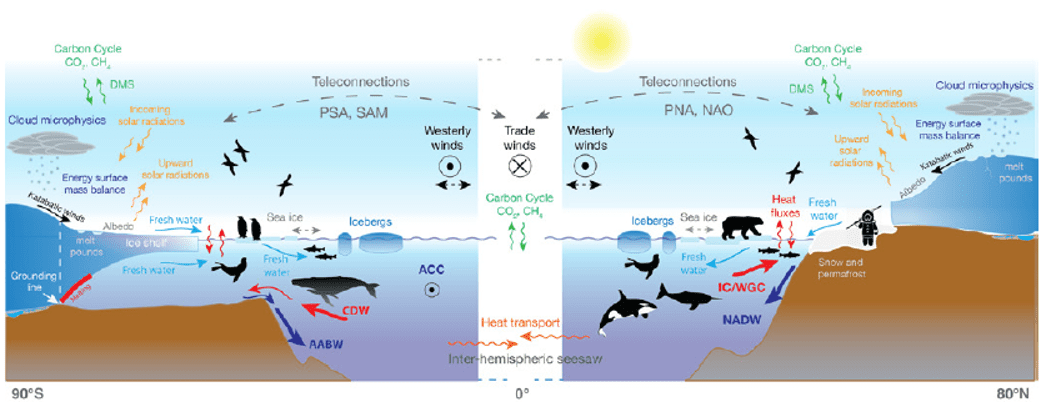Polar Research
Research in the polar regions is relevant and important for all of us and our everyday life, because of its profound effect on the Earth’s climate and ocean systems. Polar science has therefore the potential to support the sustainable use of resources, the protection of the planet and benefit humanity. “What happens at the poles does not stay at the poles”.

The polar regions have always been important to Europe, as they strongly influence, directly or indirectly, many parts of the society here. Both polar regions share some similarities – both are cold, icy, and sparsely populated (if at all); and are remote and difficult to access. While the Arctic has communities of both indigenous and local residents beyond the Arctic circle with a history going back thousands of years; the residents in the Antarctic are far fewer, and mainly consist of research and support staff at the various research stations, and the logistics operations that manage these. The lands encircling the Arctic Ocean are governed by the 8 Arctic countries, who cooperate with each other (and others) under the auspices of the Arctic Council. This includes the 6 Indigenous peoples’ organizations have been granted Permanent Participants status and have full consultation rights in connection with the Arctic Council’s negotiations and decisions.The Antarctic is a continent that is surrounded by the Southern Ocean, and is under international governance through the Antarctic Treaty System. It is important to acknowledge and understand these differences, as both polar regions can act as natural laboratories capable of providing extremely valuable insights into physical, biological and ecological processes at lower latitudes. The polar regions, particularly the Arctic, are often called the sentinels of a changing climate, as the communities and ecosystem in the polar regions are subject to multiple stresses from a changing climate and environment. The changes already happening in the Arctic are changing the lives of the residents and affecting their wellbeing. As the often repeated statement goes, “what happens at the poles does not stay at the poles”, changes at the polar regions exert a far wider influence around the globe.
Longstanding regional entities such as the European Polar Board and the Reunión de Administradores de Programas Antárticos Latinoamericanos (RAPAL), bring together a range of organisations working in the polar regions. The EPB includes national polar programmes, research institutions, government departments, national funding agencies and university centres from across Europe, representing the combined strength of European polar research; while RAPAL includes national Antarctic programs in South America that collaborate on scientific, logistical and environmental issues in the Antarctic. Due to the harsh and remote nature of the polar regions, extensive international cooperation and collaborations are a necessity for successful scientific research. Leveraging the existing collaborative links due to organisations like the EPB, large EU funded projects like EU-PolarNet are successful in further strengthening international co-operation in polar research, and sustaining a meaningful dialogue with international polar stakeholders. Bringing together EU funded projects that work in the polar regions, the EU Polar Cluster works together to increase impact, and engage a wider range of stakeholders, and to provide policy-relevant information. Other important organisations that play a key role in the polar regions are the Scientific Committee on Antarctic Research (SCAR) and the Council of Managers of National Antarctic Programs (COMNAP) for the Antarctic, and the International Arctic Science Committee (IASC) and the Forum of Arctic Research Operators (FARO) for the Arctic.

Fig: Components of the Polar System and their interactions (non exhaustive). Most of those processes and feedbacks are still poorly understood or quantified and require further observations. Pacific South/North American pattern (PSA, PNA), North Atlantic Oscillation (NAO), South Annular Mode (SAM), Dimethylsulfide (DMS), Carbon dioxide (CO2), Methane (CH4); Ocean: Antarctic Circumpolar Current (ACC), Antarctic Bottom Water (AABW), Circumpolar Deep Water (CDW), North Atlantic Deep Water (NADW), Irminger Current (IC), West Greenland Current (WGC). Fig. from EU-PolarNet white papers, and modified after Colleoni et al., 2018.
Through working in the polar regions for the last 20 years, from my experience, these are some of the important priority areas that the polar research community is working towards:
1) Climate change, including effects on local and indigenous communities: Understanding the polar processes and improving predictability will benefit the people, environmental and ecosystem management, and businesses well beyond the Polar Regions. Blue-Action aims to provide fundamental and empirically-grounded, executable science that quantifies and explains the role of a changing Arctic in increasing predictive capability of weather and climate of the Northern Hemisphere. NUNATARYUK aims to determine the impacts of thawing coastal and subsea permafrost on the global climate, and will develop targeted and co-designed adaptation and mitigation strategies for the Arctic coastal population. The SO-CHIC projects aims to understand and quantify variability of heat and carbon budgets in the Southern Ocean through an investigation of the key processes controlling exchanges between the atmosphere, ocean and sea ice using a combination of observational and modelling approaches.
2) Infrastructure and logistics: Infrastructure in the polar regions are inherently difficult to access and costly to manage. There are several cooperation initiatives between different organisations to improve access to polar infrastructure for the European research community. The EPB has set up an initiative for identifying opportunities to harmonise polar infrastructure requirements between EPB Members, and one of its key output so far is the European Polar Infrastructure Database. ARICE and INTERACT aim to better capacities for Arctic research by providing transnational access to arctic marine and terrestrial stations respectively.
3) Capacity building, and Diversity in polar research: European research in the Arctic and Antarctic is notable for its excellence, diversity and societal relevance, achieved through extensive collaboration between disciplines, institutes and countries. Building capacity in both individuals and the smaller polar programs remains an important goal for both organisations and projects working in the polar regions. Organisations like SCAR and IASC have direct actions towards this aim (Fellowships for early career researchers, indigenous engagement, Medals and honours to recognise excellence in research and outstanding service). Organisations like the EPB and RAPAL support both small and large Members and provide opportunities to collaborate and share knowledge. Association of Polar Early Career Researchers (APECS) brings together and builds the capacity of undergraduate and graduate students, early career postdoctoral and faculty members, early career professionals, educators and others with interests in Polar and Alpine regions and the wider cryosphere. Recent initiatives in polar research like Women in Polar Science, Women of the Arctic, and Gender in the Arctic have shone a light on the strengths of females in the polar regions, both resident and researchers and the struggles they have faced in their respective lives and careers. Initiatives like Pride in Polar Research and Minorities in Polar Research contribute to ongoing conversations in the polar research community about increasing diversity and making the field more inclusive.
Initiatives
No initiatives to show.
Publications
No publications to show.
